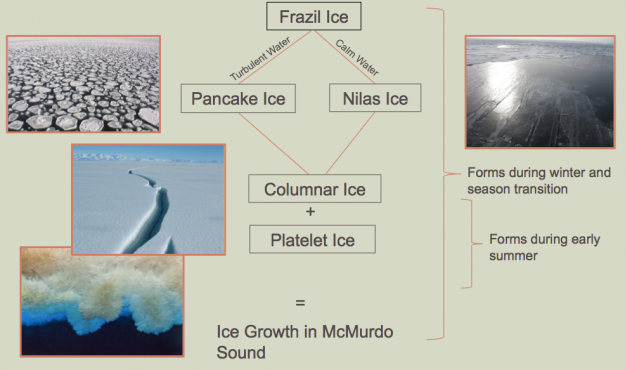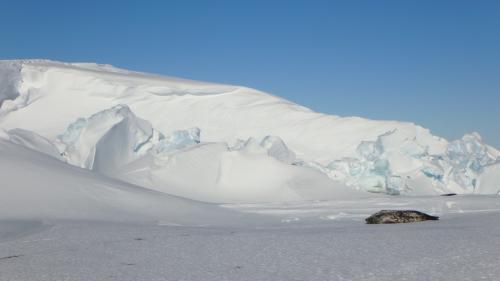Training is one of those things, just when you think you've completed it all, it turns out there's some more. I returned to the classroom yet again for training on sea ice safety since I will soon be heading out to the dive shacks and meeting up with teams that are working out on the sea ice. Obviously, traveling on a floating sheet of ice comes with its own special hazards, and being safe out there is imperative. Sea ice is something that changes throughout the year in more ways than just breaking apart (which it does, since the dock here at McMurdo is ice free – not right now, but eventually this year it will be).
Sea Ice is NOT Glacial Ice
 Mt. Erebus covered in glaciers, snow and ice, feeds the Erebus Glacier which in this photo is out of frame to the right. The large mass of ice in the middle of the photo is an iceberg from the glacier. I'm standing on sea ice which will break up later in the year to form ice floes.
Mt. Erebus covered in glaciers, snow and ice, feeds the Erebus Glacier which in this photo is out of frame to the right. The large mass of ice in the middle of the photo is an iceberg from the glacier. I'm standing on sea ice which will break up later in the year to form ice floes.
There are differences—when I was at Shear Zone camp, that was glacial ice having come from the TransAntarctic Mountains and elsewhere. Glacial ice is fresh water (hence we were able to melt it for cooking and drinking) and can be hundreds of feet thick, this is in contrast to sea ice that is frozen salt water and is generally only 6-7 feet thick around here (everything in front of McMurdo is sea ice). Glaciers break apart to form icebergs while sea ice breaks apart to form ice floes. The complexities of sea ice also involve pack ice and fast ice—pack ice being the ice that drifts around in the open ocean and is often thrust up to form great pressure ridges (which you hear polar explorers of old often describing hauling their sleds over), while fast ice is frozen in place and does not float away (this would be the case of the ice in front of McMurdo at the moment).
 Pack ice and fast ice are NOT the same thing - besides just the appearance, pack ice moves about while fast ice is basically stuck in place.
Pack ice and fast ice are NOT the same thing - besides just the appearance, pack ice moves about while fast ice is basically stuck in place.
Sea ice formation happens in a number of stages - all of which we see here in McMurdo Sound over the year. It all starts with frazil ice which are small plates of ice that are suspended like little ice crystals. Frazil ice starts to change depending on the weather conditions—if it is turbulent then the frazil ice will collect together in semi-circular pieces of ice called pancake ice which can be anywhere from 3cm to 3m in diameter with raised edges like a lily pad (the raised edge is caused by the wind blowing them around and colliding with each other), if however the water is calm then the frazil ice will form Nilas ice which is a smooth glass-like ice that is surprisingly thin when it first forms. Both of them eventually form different kinds of sea ice but for the sake of simplicity let's just call all sea ice columnar ice (I'm going to get grief over that I know) ... columnar ice forms from long crystals that freeze together and thicken the ice over time. As this begins to form, so does platelet ice which are tiny little plates of ice that freeze to the bottom of the fast ice. They are formed by super cooled water flowing from underneath the ice shelf (you might remember me talking about something like this forming under the ice shelf and forming basal ice in a previous journal). During seasonal transition, the ice can grow at over 1cm a day but eventually stops altogether right around now - the end of October.
 Sea ice can take many forms and takes all year to form into the ice that I'm walking on around McMurdo Sound.
Sea ice can take many forms and takes all year to form into the ice that I'm walking on around McMurdo Sound.
Real World Training
You could spend all day learning about sea ice (trust me I know, I did) but nothing takes the place of actually getting out there on the ice – luckily we happen to have a ton of it. During sea ice training we went out onto the sea ice to investigate cracks in the ice, and learned how to determine if it was safe to cross them in the variety of vehicles that McMurdo has to offer (everything from snowmobiles to large tracked-trucks to Hägglunds (see the photos). Out on the ice we needed to clear the snow that fills in the cracks and begin to make a field map of the crack. Sea ice cracks can tend to open and close a number of times, creating a history that needs to be understood before attempting to cross them.
 Once a crack has been located (in this case Backhoe Crack – if they are known they are named), then they are cleared. In the middle photo, SAR team member and instructor Evan works to try and clear one while I bother him with photos. Once cleared, the complex history can be more clearly seen and mapped.
Once a crack has been located (in this case Backhoe Crack – if they are known they are named), then they are cleared. In the middle photo, SAR team member and instructor Evan works to try and clear one while I bother him with photos. Once cleared, the complex history can be more clearly seen and mapped.
 Vehicles need different thicknesses of ice under them and can cross different sized cracks depending on the ice thickness and the time of year.
Vehicles need different thicknesses of ice under them and can cross different sized cracks depending on the ice thickness and the time of year.
Once the crack is clear of snow, a large drill is used to drill holes all the way through the ice so that a measuring tape can be sent all the way to the bottom to determine ice thickness. Holes are drilled along the length of the crack to determine thickness in various places since it is not consistent. Once thickness has been determined, you can use the table at right to decide if the vehicle you currently are in can cross the crack at this particular place.
 Drills with long sectional bits are used to drill through the ice so that ice thickness can be measured accurately.
Drills with long sectional bits are used to drill through the ice so that ice thickness can be measured accurately.
Views and More Views
Of course part of the amazing thing about being out on the ice are the views. In our quest to find good cracks to explore and learn from, we were able to head over to the Erebus Glacier Tongue (EGT – everything has to have an acronym) to see the sea ice being compressed up into impressive pressure ridges and even got to see a few seals that had come out onto the surface to bask in the warm sun of this calm windless day.
 Out on the sea ice in front of the Erebus Glacier Tongue with Mt. Erebus smoking away in the background. The sea ice is being pushed up dramatically as the glacier tongue continues to push its way out into the sea.
Out on the sea ice in front of the Erebus Glacier Tongue with Mt. Erebus smoking away in the background. The sea ice is being pushed up dramatically as the glacier tongue continues to push its way out into the sea.
 Warm and windless days provide for excellent sunning opportunities for the seals – this particular one was not at all concerned about our arrival in the area.
Warm and windless days provide for excellent sunning opportunities for the seals – this particular one was not at all concerned about our arrival in the area.
 Every time we could get out of the vehicle there was an opportunity to view and photograph the amazing scenery. I will not grow old of these views – every direction is something new.
Every time we could get out of the vehicle there was an opportunity to view and photograph the amazing scenery. I will not grow old of these views – every direction is something new.
 Sometimes a bit of perspective is needed to explain just how huge this place is – in an area where distances are meaningless, photos can do better to convey the vastness.
Sometimes a bit of perspective is needed to explain just how huge this place is – in an area where distances are meaningless, photos can do better to convey the vastness.
